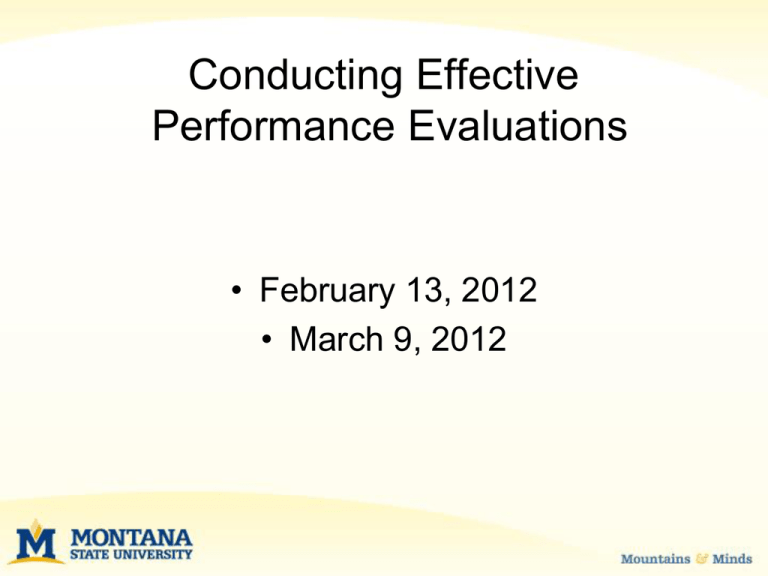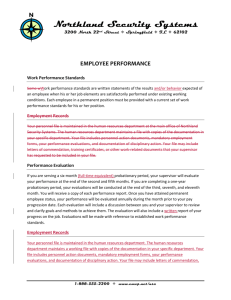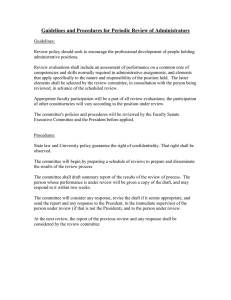Conducting Effective Performance Evaluations • February 13, 2012 • March 9, 2012
advertisement

Conducting Effective Performance Evaluations • February 13, 2012 • March 9, 2012 Performance Evaluation v. Performance Management Evaluation Management One time event Ongoing Retrospective Prospective Short Term Long Term Correction oriented Progress steps Completing form Planning/goal setting Top Five Best Practices in Performance Management • Hire the Best People, Train them Well • Have Clear Expectations – share them! • Set Goals • Communicate • Give Feedback Performance Management • Process in which management and employees work together to accomplish the mission, goals and objectives of their organization • More than an annual paper shuffle • Few jobs remain constant, early feedback is vital Performance Management • Continuous on-going process of gathering information and communication about performance • Cyclical process – planning, setting expectations, observation, evaluation • Silence = approval of behaviors Job Descriptions • Foundational tool, essential to effective performance management • Clarify job responsibilities and expectations • In legal challenge situations, provides the supervisor with the ability to prove that the employee did know the expectations and standards Performance Evaluation • Personnel Policy 600 – http://www2.montana.edu/policy/performance evaluation policy.htm • Management Best Practice • An annual performance evaluation is required for classified and contract professional employees Performance Evaluation • Management best practice; ensures unit mission, goals, and objectives are in alignment and being met • A more involved feedback session, with discussion, covering many aspects of performance over a period of time • Formal, written, No Surprises! • Done WITH the employee, not TO the employee • Communicate, communicate, communicate Performance Evaluation • Two-way communication between employee and the manager • Sets clear expectations to employees • Employees want to know what is expected of them • Facilitates employee development and growth Feedback • One of the most effective ways to reinforce or increase productivity involves providing employees with specific feedback about their performance, at a high frequency, immediately following the desired performance Keys to Successful Performance Evaluations • Identify performance expectations • Be consistent in measuring and communicating the extent to which those expectations are being met • Provide opportunities for feedback and clarification Successful Performance Evaluations Set/establish expectations and/or goals • Focus on job related skills or activities – realistic and achievable • Work performance and behaviors – objectively observable and measurable • Reasonable indicators of successful performance are expressed in terms of quality, quantity, timeliness, cost • Performance measures/indicators are subject to change, are not permanent, are not perfect Conducting the Evaluation • Plan ahead, plan for the desired outcome • No Interruptions - Take the Time, Make the Time • In writing, face-to face • Formal official document • Watch for personal biases – do not focus on personality traits • No surprises! Do’s and Don'ts • Do - Establish clear performance expectations and review annually with each person • Do - Focus on the employee’s behavior and job performance • Do - Discuss individual instance of problem performance when it arises and how the problem should be addressed More Do’s • Do - Objectively describe what the employee did or did not do • Do - Give credit where credit is due! • Do - Review patterns of poor or unacceptable performance & write plan to improve performance with deadlines and milestones • Do – Be discreet and follow up The Don'ts • Don’t generalize individual problems to the group • Don’t ignore patterns of poor job performance • Don’t become involved in personal problems • Don’t recognize a “group” for an accomplishment of an individual - - - recognize him/her! Rating Performance • Exceeds – Frequently exceeds performance standards for the position. Employee makes unique and significant contributions to the department. • Meets – Meets performance standards for the position. Consistently and effectively performs job duties. • Needs Improvement – Fails to meet performance standards for the position. Improvement is needed. Common Rating Errors • Halo/Horn – opinion of one quality influences opinion of other qualities. All the same rating. • Central Tendency – everyone in the middle, lack of rating between employees. • Leniency – avoids honest ratings to avoid conflict – everyone near the top. • Recency – greater weight to recent occurrences or events • Similarity/Like me – favorable rating to employees who have similar values or interests to the rater Classified Evaluations • http://www.montana.edu/pps/EmployeeRelations.htm • Version 1, developed with MPEA – ad hoc labor management committee • Version 2, historical form • If you wish to design an alternate evaluation tool for classified employees, it must be pre-approved by Employee & Labor Relations. Professional Evaluations • Affirmative Action Website - http://www.montana.edu/hraa/evaluations.html • Two options available – Word and Excel – can be edited to fit your needs • Please remember the COVER SHEET on all evaluations Procedure • Rebuttal process; No grievance process • An employee who disagrees with the evaluation of his or her supervisor may submit a written request for review by the supervisor’s supervisor. • The written request must outline the specific areas of disagreement and the reasons the employee disagrees with the supervisor’s evaluation. • The decision of the supervisor’s supervisor will be the final decision on the evaluation. • The employee’s written disagreement will be included with a copy of the final performance evaluation and placed in the employee’s personnel file. FAQ’s • Should probationary employees be evaluated during the probationary period? – Conduct the discussion immediately upon conclusion of the probationary period FAQ’s • My supervisor asked me to fill out a self evaluation. Is this legit? Yes! This method may meet multiple managerial needs: • Aids the face to face discussion • Self evaluation by the employee may help establish the thought processes for an effective discussion • May help align employee and supervisor understanding of the job duties Tips to Remember • Employee & Supervisor must sign the evaluation • Send in the ORIGINAL evaluations not a copy. • Complete Evaluation in Pen not pencil • Please provide LEGAL name on Cover sheet – No nicknames • Double check GID & Position number – Allows for tracking incoming evaluations & filing correctly • Remember to include the coversheet located on the websites More Tips to Remember • If you say “see attached page” …make sure to attach the page. • Self evaluation is not the Performance Evaluation that a supervisor can sign and submit without comments. • Do not place comments on a post it note • Wait until employee has been hired and is past their 6 month review to do a review • Don’t put “jokes” on Performance Evaluations i.e. under goals - “Get fired” Contact Info • • • • Susan Alt Director, Employee & Labor Relations 406-994-3344 salt@montana.edu • • • • Diane Letendre Interim Director, Human Resources | AA 406-994-2042 dletendre@montana.edu

